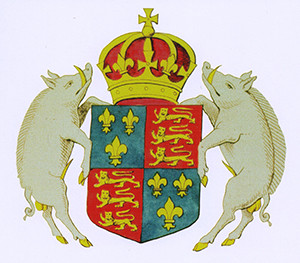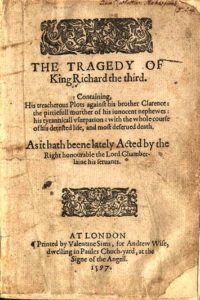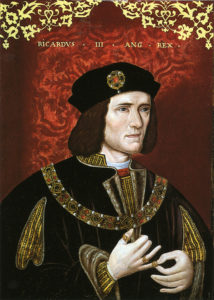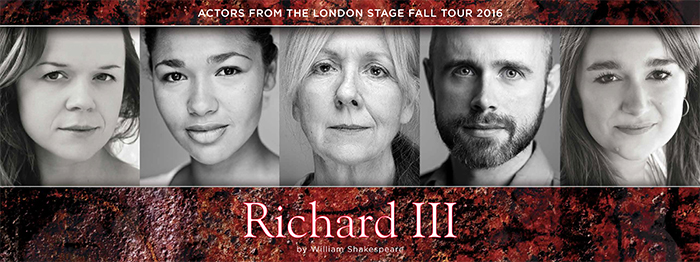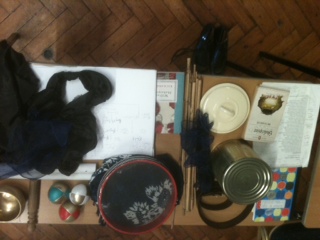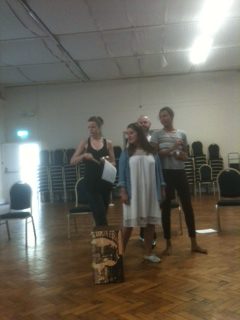We spent our last week in London reworking the play in finer detail, sometimes as a group, breaking the script down into sections and marking where we feel there are a strong gear shifts. While working on the second wooing scene with Queen Elizabeth bereft then of her husband and sons — which is a rather horrible and much tougher mirror of the first wooing scene where Richard actually manages to put a ring on the finger of the young widow whose husband he’s helped to kill along with her father-in-law whom he has killed — Evvy [Evelyn Miller] suggested clapping some of the beats to remind us where they were while we were actually playing the scene. It was really helpful and that and playing on the diagonals in the space helped us move forward.
 While finessing the first wooing scene, it was really interesting that suddenly the only chap in our cast, Paul O’Mahony, seemed to have the most excellent understanding. He told me to be very confident since Richard has definitely decided to marry this woman. Of course Paul would understand; he’s a man. I haven’t done huge amounts of wooing in my life! It’s written like a piece of music with Lady Anne and Richard finishing each other’s sentences or batting back the same rhythm. Similarly, in the scene where Queen Elizabeth, who is played by Paul, comes on having lost her little sons, all us women suddenly had a lot to say.
While finessing the first wooing scene, it was really interesting that suddenly the only chap in our cast, Paul O’Mahony, seemed to have the most excellent understanding. He told me to be very confident since Richard has definitely decided to marry this woman. Of course Paul would understand; he’s a man. I haven’t done huge amounts of wooing in my life! It’s written like a piece of music with Lady Anne and Richard finishing each other’s sentences or batting back the same rhythm. Similarly, in the scene where Queen Elizabeth, who is played by Paul, comes on having lost her little sons, all us women suddenly had a lot to say.
Usually, whoever is not in the scene or has very little in it gets to sit “out front” and see if we’re making sense and honoring the text. Shakespeare and Richard pull off the absolute impossible at the end of the first wooing scene with Lady Anne melting fatally and momentarily — as she says later – “I grew grossly captive to his honey’d words.” Richard, who says he’s marrying her “not all so much for love” BEFORE the scene, finds himself believing all he says and falling for her. I don’t think he’s had much love in his life at all (though he clearly WORSHIPPED his father). So, when he totally liberates himself by determining to “prove a villain” at the top of the play, he suddenly finds it possible to win a beautiful young woman’s attention. He is so gobsmacked when she leaves that I think he is physically and mentally reeling and even has a strange stab of feeling for her dead husband (Queen Margaret’s son ) Edward. Richard calls him “young ,valiant, wise, and no doubt right royal” and wonders if Anne is fickle for having submitted to him. Of course the wonder of Shakespeare is the multiplicity of choice one has: he could be cynical, sneering, tearful. But you KNOW that he has somehow, with Lady Anne, felt a feeling unknown to himself before that scene. Alice is a heartbreaking Lady Anne.
Later in the week, we found an intriguing way of staging Queen Margaret’s famous curse scene that predicts the demise of practically everyone on stage. She is such a fantastical chorus like creature, this Lancastrian Queen who has been banished on pain of death.  Hannah is using a brass singing bowl which when circled makes an eerie sound that is loud but seems to appear from nowhere. She taps it on each of her curses and we all make these involuntary movements as if being physically compelled towards her. At the beginning Margaret has asides where she is supposed to be unseen. Usually the actress would be high above or below and we played with the idea of her coming through the audience but, on Alice’s suggestion, decided to physically freeze on her asides as if Margaret has such power that she can suspend Time itself. Hannah experimented with long bits of string and silky material that she knotted as she spoke each curse but she has found something wonderfully unnerving crouching on a chair with this brass bowl as a sort of comforter.
Hannah is using a brass singing bowl which when circled makes an eerie sound that is loud but seems to appear from nowhere. She taps it on each of her curses and we all make these involuntary movements as if being physically compelled towards her. At the beginning Margaret has asides where she is supposed to be unseen. Usually the actress would be high above or below and we played with the idea of her coming through the audience but, on Alice’s suggestion, decided to physically freeze on her asides as if Margaret has such power that she can suspend Time itself. Hannah experimented with long bits of string and silky material that she knotted as she spoke each curse but she has found something wonderfully unnerving crouching on a chair with this brass bowl as a sort of comforter.
She’s very powerful and Shakespeare’s gives her such frightening words. For instance, she addresses Richard as an “elvish mark’d abortive rooting hog.” In Shakespeare’s time, anyone with a physical disability was considered literally marked by elves and God’s revenge for bad deeds. The rooting hog relates to the white boar that was part of Richard’s royal arms (at right). Hannah is also our divine dance captain and chief songstress along with Evvy (our quietly fabulous Buckingham) who has given us some great dynamics for our last ‘Te Deum’ and we’ve managed some rather gorgeous harmonies that the brilliant Conrad Nelson has given us.
This week, we had the very lovely Richard Neale “on the book” for us (i.e. giving lines and prompting). Normally there would be a deputy stage manager from day one, so it was a bit of a shock to realize that some bits had just bedded in WRONG. Usually you bat off people who ask “How do you learn your lines?” but, as we each share a fifth of a two hour fifteen minute Shakespeare play, it has been seriously challenging. The process has been vocally tiring as well — many tired vocal chords and much steaming. We’ve gradually, as we are responsible for ALL our choices, rushed out before rehearsals or in the lunch hour and found our COSTUMES. Paul has some dazzling shoes with an electric blue sole, a rather lovely black fur scarf of my Mum’s for his proud and fiercely intelligent Queen Elizabeth, and a handkerchief for his hilarious sweating and constantly unpunctual Lord Hastings. I’ve gone for culottes and a long waistcoat in pinstripes and a crown made out of garden and picture wire (that needed some serious attention as it kept getting stuck in our hair). Alice has gone for a top hat as Lord Rivers and geeky glasses for the Lord Mayor with a black veil for lady Anne. Hannah has a bright red beret as a female Catesby and fine pieces of cloth for Clarence, King Edward, and Queen Margaret. Evvy uses a flat cap for Lord Derby and a silk cravat for Buckingham. Everything needs to be simple and read INSTANTLY. It also needs to weigh under 23 kilos. We did a run through for ourselves and then the hair-raising Thursday run in front of our Associate Directors but it was actually great to have an audience. Richard needs to have someone with whom to share all his devilish plots. They enjoyed the performance and you will too. America, here we come.
– Liz Crowther
[The tour is currently in residence at the University of Texas at Austin and next week travels 90 minutes south to the University of Texas at San Antonio.]

